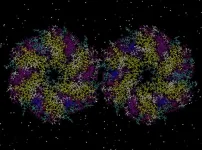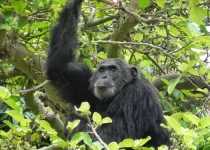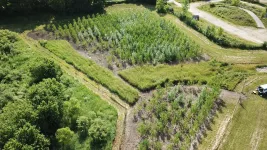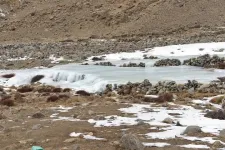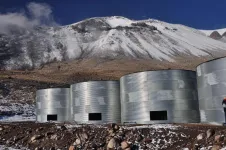(Press-News.org) RESEARCH TRIANGLE PARK, N.C. -- New Army-funded synthetic biology research manipulated micro-compartments in cells, potentially enabling bio-manufacturing advances for medicine, protective equipment and engineering applications.
Bad bacteria can survive in extremely hostile environments -- including inside the highly acidic human stomach--thanks to their ability to sequester toxins into tiny compartments.
In a new study, published in ACS Central Science, Northwestern University researchers controlled protein assembly and built these micro-compartments into different shapes and sizes, including long tubes and polyhedrons. Because this work illuminates how biological units, such as viruses and organelles, develop, it also could inform new ways to design medicine, synthetic cells and nano-reactors that are essential for nanotechnology.
"These results are an exciting step forward in our ability to design complex protein-based compartments," said Dr. Stephanie McElhinny, program manager at the U.S. Army Combat Capabilities Development Command, known as DEVCOM, Army Research Laboratory. "Being able to control the size and shape of these compartments could enable sophisticated bio-manufacturing schemes that are customized to support efficient production of complex molecules and multi-functional materials that could provide the future Army with enhanced uniforms, protective equipment and environmental sensors."
Further down the road, these insights potentially could lead to new antibiotics that target micro-compartments of pathogens while sparing good bacteria.
Researchers control protein assembly and build cell micro-compartments into different shapes and sizes that could lead to bio-inspired building blocks for various engineering applications.
"By carefully designing proteins to have specific mutations, we were able to control assembly of the proteins that form bacterial micro-compartments," said Dr. Monica Olvera de la Cruz, professor of materials science and engineering and chemistry at Northwestern who led the theoretical computation. "We used this also to predict other possible formations that have not yet been observed in nature."
Many cells use compartmentalization to ensure that various biochemical processes can occur simultaneously without interfering with one another. Made of proteins, these micro-compartments are a key to survival for a wide variety of bacterial species.
"Based on previous observations, we have known that the geometry of micro-compartments can be altered," said Dr. Danielle Tullman-Ercek, associate professor of chemical and biological engineering at Northwestern who led the experimental work. "But our work provides the first clues into how to alter them to achieve specific shapes and sizes."
To study these crucial compartments, the Northwestern team turned to Salmonella enterica, which rely on micro-compartments to break down the waste products of good bacteria in the gut. When the researchers genetically manipulated a protein isolated from Salmonella, they noticed the micro-compartments formed long tubes.
"We saw these weird, extended structures," Tullman-Ercek said. "It looked like they used the varying building blocks to form different shapes with different properties."
By coupling the mechanical properties of the compartment with the chemicals inside the compartment, Olvera de la Cruz and her team used theoretical computation to predict how different mutations led to different shapes and sizes. When six-sided proteins assembled together, they formed long tubes. When five-sided proteins assembled together, they formed soccer ball-shaped icosahedrons. The team also predicted that proteins could assemble into a triangular samosa shape, resembling the fried, South Asian snack.
Understanding this process could lead to bio-inspired building blocks for various engineering applications that require components of varying shapes and sizes.
"It's like building with Legos," Tullman-Ercek said. "It's not desirable to use the same shape block over and over again; we need different shapes. Learning from bacteria can help us build new and better structures at this microscopic scale."
INFORMATION:
In addition to the U.S. Army, the Department of Energy, the National Science Foundation and the Sherman Fairchild Foundation supported this research.
Visit the laboratory's Media Center to discover more Army science and technology stories
DEVCOM Army Research Laboratory is an element of the U.S. Army Combat Capabilities Development Command. As the Army's corporate research laboratory, ARL is operationalizing science to achieve transformational overmatch. Through collaboration across the command's core technical competencies, DEVCOM leads in the discovery, development and delivery of the technology-based capabilities required to make Soldiers more successful at winning the nation's wars and come home safely. DEVCOM is a major subordinate command of the Army Futures Command.
Boston - This year, more than 60,000 adults in the United States will be diagnosed with pancreatic cancer and, statistically, as few as 10 percent will survive five years after diagnosis, according to the American Cancer Society. Because pancreatic cancer is hidden deep within the body and often symptomless, it's frequently diagnosed after the disease has progressed too far for surgical intervention and/or has spread throughout the body. Research indicates that earlier detection of pancreatic tumors could quadruple survival rates; however, no validated and reliable tests for early detection of pancreatic cancer currently exist.
Now, researchers at the Cancer Research Institute at Beth Israel Deaconess Medical Center (BIDMC) have successfully created ...
Every day, the sun ejects large amounts of a hot particle soup known as plasma toward Earth where it can disrupt telecommunications satellites and damage electrical grids. Now, scientists at the U.S. Department of Energy's (DOE) Princeton Plasma Physics Laboratory (PPPL) and Princeton University's Department of Astrophysical Sciences have made a discovery that could lead to better predictions of this space weather and help safeguard sensitive infrastructure.
The discovery comes from a new computer model that predicts the behavior of the plasma in the region above the surface of the sun known as the solar corona. The model was originally inspired by a similar model that describes the behavior of the plasma that fuels fusion reactions in doughnut-shaped fusion facilities known ...
Although plants may look fairly inactive to casual observers, research into plant biology has shown that plants can send each other signals concerning threats in their local environments. These signals take the form of airborne chemicals, called volatile organic compounds (VOCs), released from one plant and detected by another, and plant biologists have found that a diverse class of chemicals called terpenoids play a major role as airborne danger signals.
Past studies have shown that soybean and lima bean plants both release terpenoid signals that activate defense-related genes in neighboring plants of the same species, and this chemically induced gene activation can help the plants protect themselves from ...
It's well established that infectious disease is the greatest threat to the endangered chimpanzees made famous by the field studies of Jane Goodall at Gombe National Park in Tanzania. Now, new research led by scientists at Emory University shows that nearly half of the fecal samples from wild chimpanzees contain bacteria that is resistant to a major class of antibiotics commonly used by people in the vicinity of the park.
The journal Pathogens published the findings.
"Our results suggest that antibiotic-resistant bacteria is actually spreading from people to non-human primates by making its way into the local watershed," says Thomas Gillespie, senior author ...
Rhinelander, Wis., April 28, 2021-- A research team from the USDA Forest Service and the University of Missouri has developed a new contaminant prioritization tool that has the potential to increase the effectiveness of environmental approaches to landfill clean-up.
Phytoremediation - an environmental approach in which trees and other plants are used to control leachate and treat polluted water and soil - hinges on matching the capability of different tree species with the types of contaminants present in soil and water. Identifying the worst contaminants ...
LAWRENCE -- College students across the country struggle with a vicious cycle: Test anxiety triggers poor sleep, which in turn reduces performance on the tests that caused the anxiety in the first place.
New research from the University of Kansas just published in the International Journal of Behavioral Medicine is shedding light on this biopsychosocial process that can lead to poor grades, withdrawal from classes and even students who drop out. Indeed, about 40% of freshman don't return to their universities for a second year in the United States.
"We were interested in finding out what predicted students' performance in statistics classes ...
MINNEAPOLIS/ST.PAUL (04/28/2021) -- In a recent discovery by University of Minnesota Medical School, researchers uncovered a new way to potentially target and treat late-stage colorectal cancer - a disease that kills more than 50,000 people each year in the United States. The team identified a novel mechanism by which colorectal cancer cells evade an anti-tumor immune response, which helped them develop an exosome-based therapeutic strategy to potentially treat the disease.
"Late-stage colorectal cancer patients face enormous challenges with current treatment options. Most of the time, the patient's immune system cannot efficiently fight against tumors, even with the ...
Seasonally occurring fields of aufeis (icing) constitute an important resource for the water supply of the local population in the Upper Indus Basin. However, little research has been done on them so far. Geographers at the South Asia Institute of Heidelberg University have now examined the spreading of aufeis and, for the first time, created a full inventory of these aufeis fields. The more than 3,700 accumulations of laminated ice are important for these high mountain areas between South and Central Asia, particularly with respect to hydrology and climatology.
In the semi-arid Himalaya regions of India and Pakistan, meltwater from snow and glaciers plays an essential role for irrigation in local agriculture and hydropower generation. In ...
LOS ALAMOS, N.M., April 28, 2021--Analysis of data from a lightning mapper and a small, hand-held radiation detector has unexpectedly shed light on what a gamma-ray burst from lightning might look like - by observing neutrons generated from soil by very large cosmic-ray showers. The work took place at the High Altitude Water Cherenkov (HAWC) Cosmic Ray Observatory in Mexico.
"This was an accidental discovery," said Greg Bowers, a scientist at Los Alamos National Laboratory and lead author of the study published in Geophysical Research Letters. "We set up this system to study terrestrial gamma-ray flashes - or gamma-ray bursts from lightning - that are ...
New research from the University of Virginia School of Medicine has shed light on the No. 1 cause of epilepsy deaths, suggesting a long-sought answer for why some patients die unexpectedly following an epileptic seizure.
The researchers found that a certain type of seizure is associated with sudden death in a mouse model of epilepsy and that death occurred only when the seizure induced failure of the respiratory system.
The new understanding will help scientists in their efforts to develop ways to prevent sudden unexpected death in epilepsy (SUDEP). Based on their research, the UVA team has already identified potential approaches to stimulate breathing in the ...
